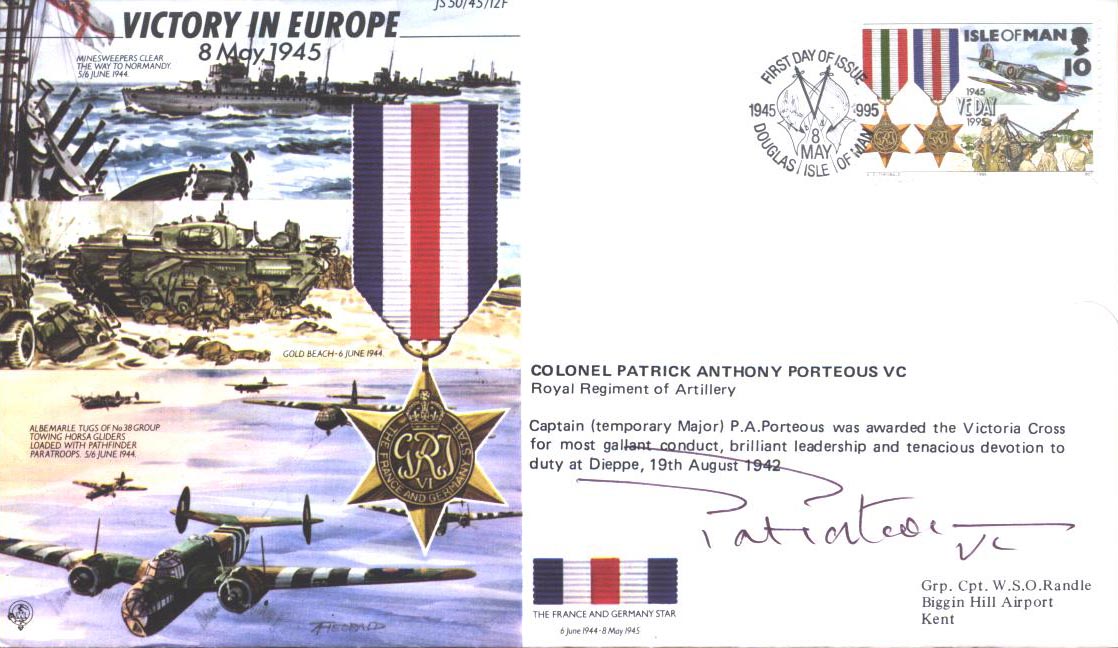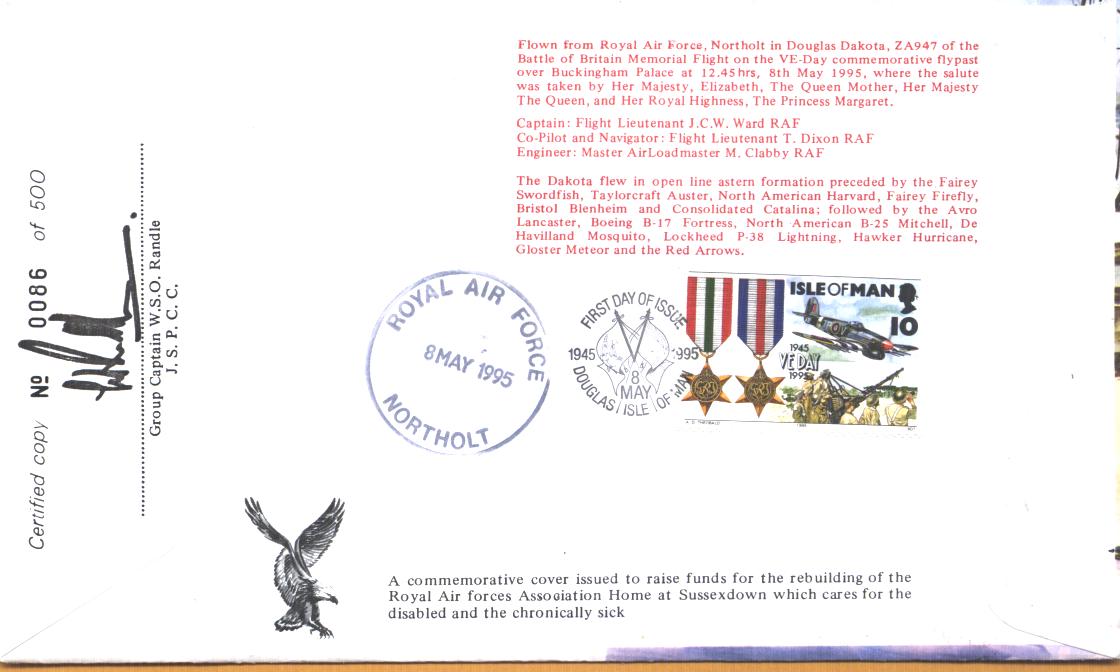

|
PORTEOUS Patrick Anthony
Colonel Patrick Anthony Porteous VC (1 January 1918 – 9 October 2000)
Porteous was commissioned in the Royal Regiment of Artillery in 1937.On 26 August 1940 he was promoted to lieutenant.[ On 19 August 1942, he was 24 years old and a temporary captain attached to No. 4 Commando when he did the deed for which he was awarded the VC, during the Dieppe Raid. The citation was published in a supplement to the London Gazette of 2 October 1942 and read:
War Office, 2nd October, 1942.
The KING has been graciously pleased to approve the award of The VICTORIA CROSS to: —
Captain (temporary Major) Patrick Anthony Porteous (73033), Royal Regiment of Artillery (Fleet, Hants.).
At Dieppe on the 19th August, 1942, Major Porteous was detailed to act as Liaison Officer between the two detachments whose task was to assault the heavy coast defense guns.
In the initial assault Major Porteous, working with the smaller of the two detachments, was shot at close range through the hand, the bullet passing through his palm and entering his upper arm. Undaunted, Major Porteous closed with his assailant, succeeded in disarming him and killed him with his own bayonet thereby saving the life of a British Sergeant on whom the German had turned his aim.
In the meantime the larger detachment was held up, and the officer leading this detachment was killed and the Troop Sergeant-Major fell seriously wounded. Almost immediately afterwards the only other officer of the detachment was also killed.
Major Porteous, without hesitation and in the face of a withering fire, dashed across the open ground to take over the command of this detachment. Rallying them, he led them in a charge which carried the German position at the point of the bayonet, and was severely wounded for the second time. Though shot through the thigh he continued to the final objective where he eventually collapsed from loss of blood after the last of the guns had been destroyed.
Major Porteous's most gallant conduct, his brilliant leadership and tenacious devotion to a duty which was supplementary to the role originally assigned to him, was an inspiration to the whole detachment.
Colonel Pat Porteous VC
12:00AM BST 11 Oct 2000 Obituary Telegraph
Commando who won the Victoria Cross leading a bayonet charge against a vital German battery in the Dieppe raid
COLONEL PAT PORTEOUS, who has died aged 82, won the Victoria Cross on August 19 1942 when serving with No 4 Commando in the Dieppe raid.
Operation Cauldron, as the assault on Dieppe was code-named, was the biggest raid of the Second World War; the attacking force of nearly 6,000 men was drawn from the 2nd Canadian Division and three British Commandos. The aim was to see if it was possible to capture a port on the French coast prior to a full-scale invasion. In the event, the raid proved such a disaster that on D-Day two years later landings on the open beaches were preferred.
No 4 Commando, in which Porteous was serving, was the only unit to capture its objective. The Canadians, in the centre of the assault, had never been in action before, and to their dismay found that their tanks were unable to negotiate the stony beach; they were cut to pieces by fire from carefully sited strongpoints that had been tunnelled out of the cliff.
When the landing force withdrew, it had suffered 3,670 casualties, lost 29 tanks, 106 aircraft and a destroyer. The Germans had lost 591 men. No 4 Commando, commanded by the intrepid Lord Lovat, numbered 252 soldiers. It landed three and a half miles west of the main attack and advanced in two sections.
One was to make its way up a river valley, then climb a slope, push on through a wood, overcome defended positions and demolish the six-gun German battery which had been sited at Varengeville. The other section of the Commandos was to make a slightly more direct approach on the target. Porteous, then a temporary Captain, was liaison officer between the two groups.
The Commandos crept forward in the dark and destroyed barbed wire, telephone lines and some German defences, and succeeded in crossing a minefield. When daylight came they were confronted by 35 German assault troops, whom they killed, but others soon took their place and the Commandos began to lose men too.
During the initial assault on the battery, Porteous found himself with the smaller of the two detachments. He was shot at close range by a German, the bullet passing through his hand and his arm. Undaunted, Porteous, using the other hand, shot his assailant dead.
Next, Porteous saved the life of a sergeant by disarming his attacker and despatching the German with his own bayonet. In the meantime, the larger detachment had been held up, its two officers killed and the troop sergeant seriously wounded.
Without hesitating, and in the face of withering fire, Porteous dashed across open ground to take charge of this section. He rallied them, and then led a bayonet charge which carried the battery. Porteous was the first to reach the guns, and as he did so was severely wounded for a second time, being shot through the thigh.
He fell, but carried on to the final objective, only losing consciousness from loss of blood once he had organised the successful demolition of the battery. An elderly Frenchwoman who had witnessed part of the action presented each of the surviving Commandos with a newly laid egg, a much appreciated gift, eggs being scarce in England at that time.
If the battery at Varengeville had not been destroyed, casualties among shipping and the main attacking force would have been even greater than they were. The battery was stubbornly defended by 250 Germans, behind concrete, wire, landmines, mortars and concealed machine gun posts. One hundred and fifty Germans were killed.
Luck played its part. As the Commandos secured their objective, a squadron of Messerschmitts swept in low overhead - but took the Commandos for Germans. The British waved cheerfully at them and were relieved to receive a wave back from the squadron leader. Porteous received news of his award from his mother while in hospital.
The citation for Porteous's VC stated: "Captain Porteous's most gallant conduct, his brilliant leadership and tenacious devotion to duty . . . were an inspiration to the whole detachment." He was invested with his Victoria Cross by King George VI on October 28 1942. Porteous told reporters outside: "It was just luck I got the award."
Patrick Anthony Porteous, the son of Brigadier-General C McL Porteous of the 9th Gurkhas, was born at Abottabad, on the North-West Frontier of India, on New Year's Day 1918. He grew up in India but was educated at Wellington, where he was an outstanding rugby player and swimmer, and then at Woolwich. He was commissioned into the Royal Artillery in 1937.
He served in France from September 1939 to May 1940 with 6th AA Regiment, RA, but after being evacuated at Dunkirk joined No 4 Commando in late 1940. After recovering from his wounds taken at Dieppe, he returned to duty and landed in Normandy, near Ouistreham, on June 6 1944 as second-in-command of No 4 Commando.
In October 1944 he returned to No 4 Training Regiment, RA, and the following December was posted to No 1 Air Landing Light Regiment, RA with whom he made a brief visit to Norway after VE Day. In June 1945 he was posted to 53 Air Landing Light Regiment, RA, with whom he served in Palestine from November 1945 to March 1946.
He then attended the Staff College, Camberley, prior to being posted to HQ RA 16 Airborne Division until January 1947, as Brigade Major. From February 1948 to April 1949 he was a Battery Commander with 33 Airborne Light Regiment. Later he served in Germany, and was an instructor and Company Commander at Sandhurst. After this he was posted to GHQ Far East Land Forces as Deputy Assistant Quarter Master General in Singapore for two years.
From 1956 until 1958 he was with 14 Field Regiment, RA. Other postings included three years as Colonel, General Staff at the War Office, the Directorate of Land/Air Warfare, and a final three years as Commander Rheindahlen Garrison. In 1970 he retired, the only officer VC then serving in the Army.
He began his first few weeks of civilian life on the dole, but then worked for an insurance firm and an estate agent. A quiet, extremely modest and unassuming man, who was always cheerful despite continuing pain from his injuries, Pat Porteous was latterly vice-chairman of the VC and GC Association. He was in the leading car at the Queen Mother's 100th Birthday Parade earlier this year.
He married first, in 1943, Lois Roome, daughter of Major-General Sir Horace Roome. She died in 1953; they had a son, who died in 1998, and a daughter. He married secondly, in 1955, Deirdre King; they had three daughters.
Signed Postal Cover
Price: $40.00
Please contact us before ordering to confirm availability and shipping costs.
Buy now with your credit card
other ways to buy
|


